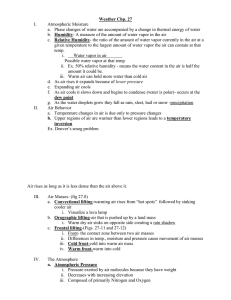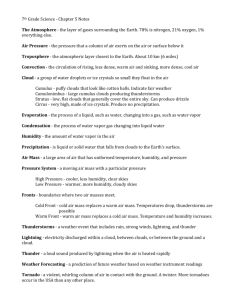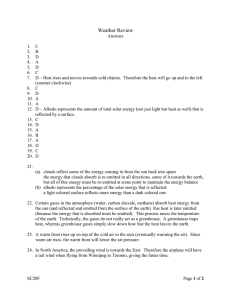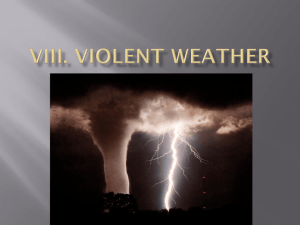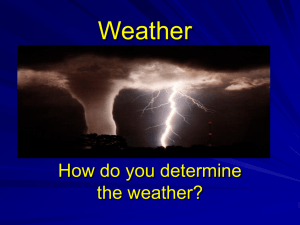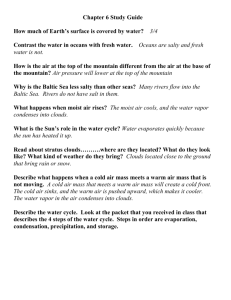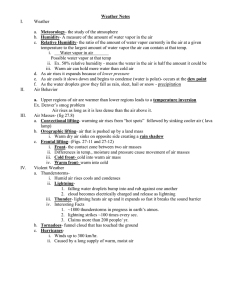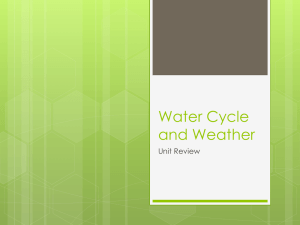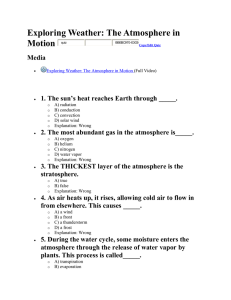Weather Chp. 27 change in thermal energy of water
advertisement
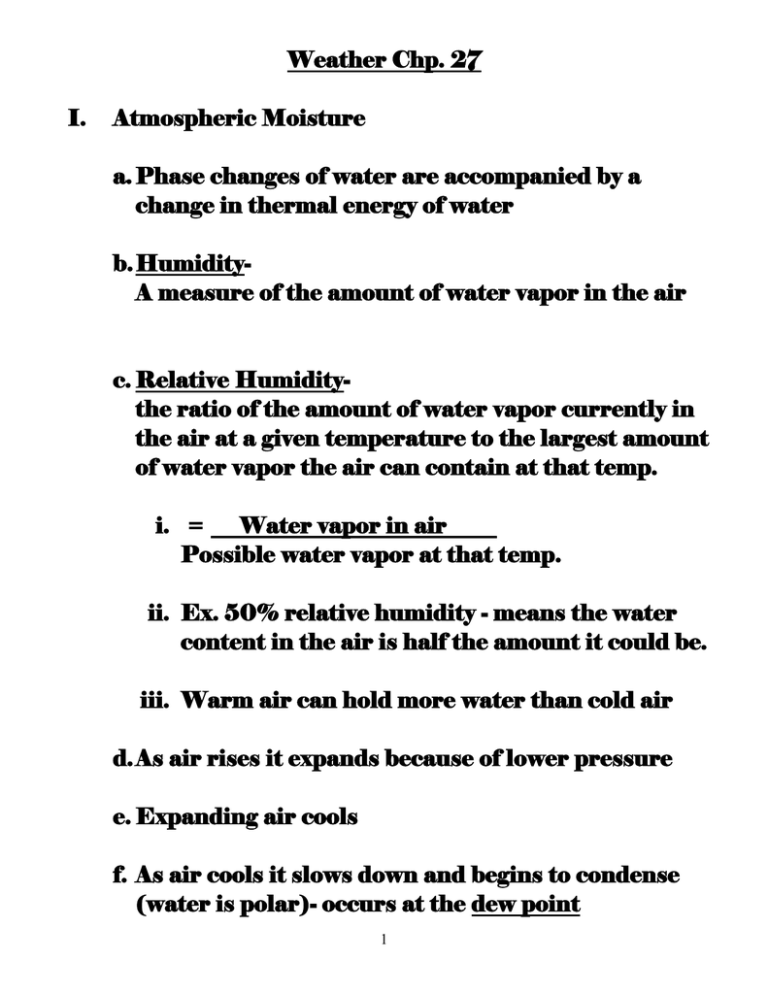
Weather Chp. 27 I. Atmospheric Moisture a. Phase changes of water are accompanied by a change in thermal energy of water b. HumidityA measure of the amount of water vapor in the air c. Relative Humiditythe ratio of the amount of water vapor currently in the air at a given temperature to the largest amount of water vapor the air can contain at that temp. i. = Water vapor in air Possible water vapor at that temp. ii. Ex. 50% relative humidity - means the water content in the air is half the amount it could be. iii. Warm air can hold more water than cold air d. As air rises it expands because of lower pressure e. Expanding air cools f. As air cools it slows down and begins to condense (water is polar)- occurs at the dew point 1 g. As the water droplets grow they fall as rain, sleet, hail or snow - precipitation II. Air Behavior a. Temperature changes in air is due only to pressure changes b. Upper regions of air are warmer than lower regions leads to a temperature Inversion 2 E.g. Denver’s smog problem If no wind - Cold air above holds pollution under it, low to the ground ★Air rises as long as it is less dense than the air above it. III. (figure 27.7) a. High Clouds- (cirro) i. Cirrus – wispy 3 ii. Cirrostratus - sheet like 4 iii. Cirrocumulus - fish scales 5 6 b. Middle Clouds - (alto) i. Altostratus - prevent shadows 7 ii. Altocumulus - long puffy strips or blotches 8 c. Low clouds i. Stratus - gray and cover entire sky 9 10 ii. Stratocumulus - wide gray, puffy clouds iii. Nimbostratus - Cover sky, wet looking, “fog” 11 d. Vertical Clouds i. Cumulus – pillowy 12 ii. Cumulonimbus - anvil shaped, tall clouds, produce tornadoes 13 IV. Air Masses- (fig 27.8) a. Convectional lifting – warming air rises from “hot spots” followed by sinking cooler air i. Visualize a lava lamp b. Orographic lifting - air that is pushed up by a land mass i. Warm dry air sinks on opposite side creating a rain shadow c. Frontal lifting - (Figs. 27-11 and 27-12) i. Front - the contact zone between two air masses 14 ii. Differences in temp., moisture and pressure cause movement of air masses iii. Cold front - cold into warm air mass iv. Warm front - warm into cold V. The Atmosphere a. Atmospheric Pressure i. Pressure exerted by air molecules because they have weight ii. Decreases with increasing elevation iii. Composed of primarily Nitrogen and Oxygen b. Layers of the Atmosphere i. Thermosphere 1. 90 - 500 km ii. Mesosphere 1. 50 - 90 km 15 iii. Stratosphere 1. 16 - 50 km 2. contains the ozone layer 3. 99% of atmosphere is below 35 km iv. Troposphere 1. 16 km at the equator 2. 8 km at poles 3. commercial jets fly at the top of troposphere to avoid weather 4. 90% of atmosphere’s air mass 5. all water vapor and clouds 16 VI. Violent Weather a. Thunderstorms i. Humid air rises cools and condenses 17 ii. Lightning 1. falling water droplets bump into and rub against one another 2. cloud becomes electrically charged and release as lightning 18 iii. Thunder - lightning heats air up and it expands so fast it breaks the sound barrier 19 iv. Fun Facts 1. ~1800 thunderstorms in progress in earth’s atmos. 2. lightning strikes ~100 times every sec. 3. Claims more than 200 people/ yr. b. Tornadoes – funnel cloud that has touched the ground 20 21 Oklahoma Tornado Tornado c. Hurricanes (Typhoons in the Pacific) i. Winds up to 300 km/hr. 22 ii. Caused by a long term supply of warm, moist air iii. Lose power as they move onto land Hurricane Rita 23 Hurricane from Space Shuttle 24 Hurricane Katrina 25 Hurricane Dennis 26 Hurricane X Hurricane Wilma 27
